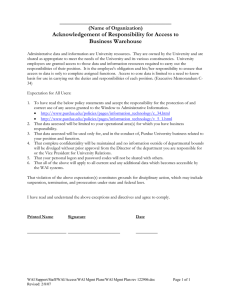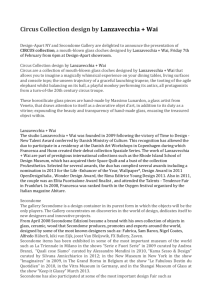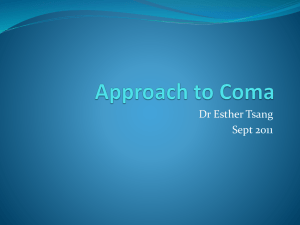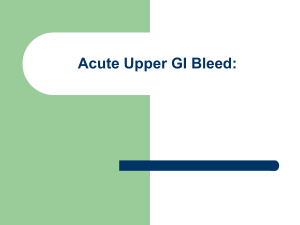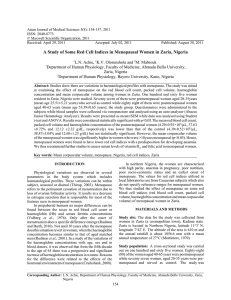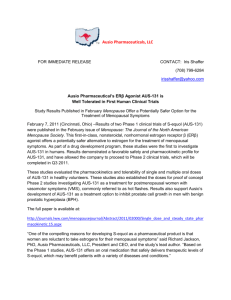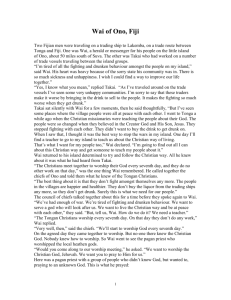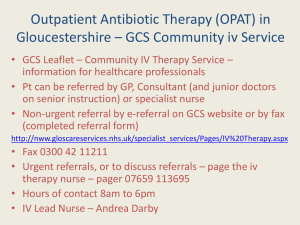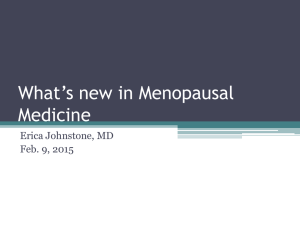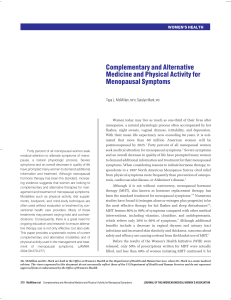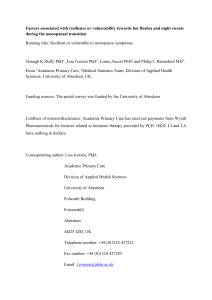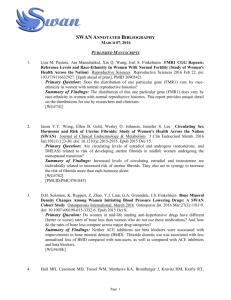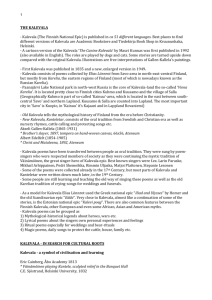Increased menopausal symptoms are related to
advertisement
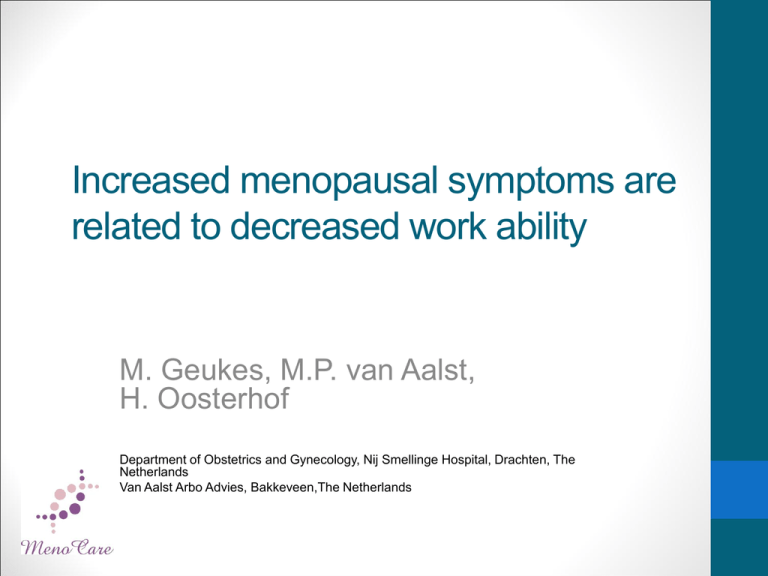
Increased menopausal symptoms are related to decreased work ability M. Geukes, M.P. van Aalst, H. Oosterhof Department of Obstetrics and Gynecology, Nij Smellinge Hospital, Drachten, The Netherlands Van Aalst Arbo Advies, Bakkeveen,The Netherlands Women & work; The Netherlands • Half the total workforce; 4 million • Age > 50 years; 2.7 million • Increase from 22% to 41% last decade • Expected increase in next decade Work ability • Built on the balance between a persons resources and work demands • Can predict both future impairment and duration of sickness absence • The Finnish Institute of Occupational Health developed the Work Ability Index (WAI) lmarinen J. Towards a Longer Worklife! Ageing and the Quality of Worklife in the European Union. Helsinki, Finland: Finnish Institute of Occupation Health, Ministry of Social Affairs and Health, 2005. Ilmarinen J, Tuomi K, Klockars M. Changes in the work ability of active employees over an 11-year period. Scand J Work Environ Health 1997; 23:49-57. Reiso H, Nygard JF, Brage S, Gulbrandsen P, Tellnes G. Work ability and duration of certified sickness absence. Scand J Public Health 2001; 29:218-225. Tuomi K, Ilmarinen J, Jakhola A, Katajarinne L, Tulkki A. Work Ability Index, 2nd revised ed. Helsinki, Finland: Finnish Institute of Occupational Health, 1998. Work Ability Index (WAI) 1. Current work ability compared with best of lifetime; 2. Work ability in relation to job demand; 3. Number of current diseases diagnosed by a physician; 4. Estimated work impairment due to disease; 5. Sickness absence during the past 12 months; 6. Own prognosis of work ability 2 years from now; 7. Mental resources (refers to the worker’s life in general, both at work and during leisure-time). Work Ability Index • Score runs from 7 to 49 points • < 37 points indicate “poor” work ability • ≥ 37 points indicate “good/excellent” work ability Determinants of poor work ability • Older age • Lower education • Being overweight • Smoking • Lack of exercise van den Berg TI, Elders LA, de Zwart BC, Burdorf A. The effects of work-related and individual factors on the Work Ability Index: a systematic review. Occup Environ Med 2009;66:211-220. Work ability and menopausal symptoms • 33.8% of the variance in WAI score is explained by total GCS score Geukes M, van Aalst MP, Nauta MCE, Oosterhof H. The impact of menopausal symptoms on work ability. Menopause 2012;19:278-282. Details of this study • Objective: to analyze the ability to work among women who seek help for their menopausal symptoms • Design: cross-sectional study • Setting: the study was conducted in Northern Netherlands, province Friesland Study population • Patients: first-time attendees of a menopause clinic • Controls: healthy female workers • Inclusion criteria • Age 44 to 60 years • Exclusion criteria • Currently unemployed • Incomplete questionnaires Methods • Questionnaires assessing work ability (Work Ability Index: WAI), menopausal symptoms (Greene Climacteric Scale: GCS) and individual and lifestyle factors • Statistics • independent samples t test for differences between means (GCS/WAI) • Cramer’s V to measure differences in individual and lifestyle factors Population characteristics Characteristic Patient n = 35 Control n = 194 Total n = 229 P value Age (years) Median (range) 51 (44-59) 51 (44-60) 51 (44-60) 0.852 Education no. (%) Primary education Secondary education Higher education 1 (2.9) 23 (65.7) 11 (31.4) 2 (1.0) 118 (61.1) 73 (37.8) 3 (1.3) 141 (61.8) 84 (36.8) 0.556 No significant differences in individual and lifestyle factors Smoking no. (%) Never Quit < 10 cigarettes/day > 10 cigarettes/day 12 (34.3) 20 (57.1) 2 (5.7) 1 (2.9) 73 89 16 14 (38.0) (46.4) (8.3) (7.3) Exercise no. (%) (Almost) none 1-3 times/month 1-2 times/week 3-5 times/week 6-7 times/week 8 (22.9) 5 (14.3) 14 (40.0) 6 (17.1) 2 (5.7) 61 19 85 28 1 BMI (kg/m²) 25.56 ± 4.97 25.32 ± 4.18 (31.4) (9.8) (43.8) (14.4) (0.5) 0.580 85 (37.4) 109 (48.0) 18 (7.9) 15 (6.6) 69 24 99 34 3 0.105 (30.1) (10.5) (43.2) (14.8) (1.3) 25.36 ± 4.30 0.764 Results Patient n = 35 Control n = 194 P value 24.20 ± 8.41 14.20 ± 7.68 <0.001 Anxiety score 7.11 ± 2.96 3.82 ± 2.19 <0.001 Depression score 5.14 ± 2.61 3.38 ± 2.53 <0.001 Psychological score 12.26 ± 4.93 7.20 ± 4.30 <0.001 Somatic score 6.83 ± 3.79 3.99 ± 2.99 <0.001 Vasomotor score 3.71 ± 1.99 2.03 ± 1.67 <0.001 Sexual dysfunction score 1.40 ± 1.01 0.98 ± 0.86 0.025 Total GCS-score Poor WAI-score 65.7% 34.0% 32.33 ± 6.75 versus 38.55 ± 6.24 <0.001 WAI-score WAI no. (%) < 37 (poor) ≥ 37 (good/excellent) <0.001 23 (65.7) 12 (34.3) 66 (34.0) 128 (66.0) Conclusions • Women who seek help for their menopausal symptoms; • are significant more bothered by those symptoms than their healthy controls (total GCS 24.20 vs. 14.20) • report significant lower work ability than their healthy controls (WAI score 32.33 vs. 38.55) • report a poor work ability in 65.7% • are at risk for developing sickness absence • Menopause seems to be an important economic burden Further study • Effect of (different) treatment (options) on work ability • Lifestyle changes • Counseling – coping • HRT
